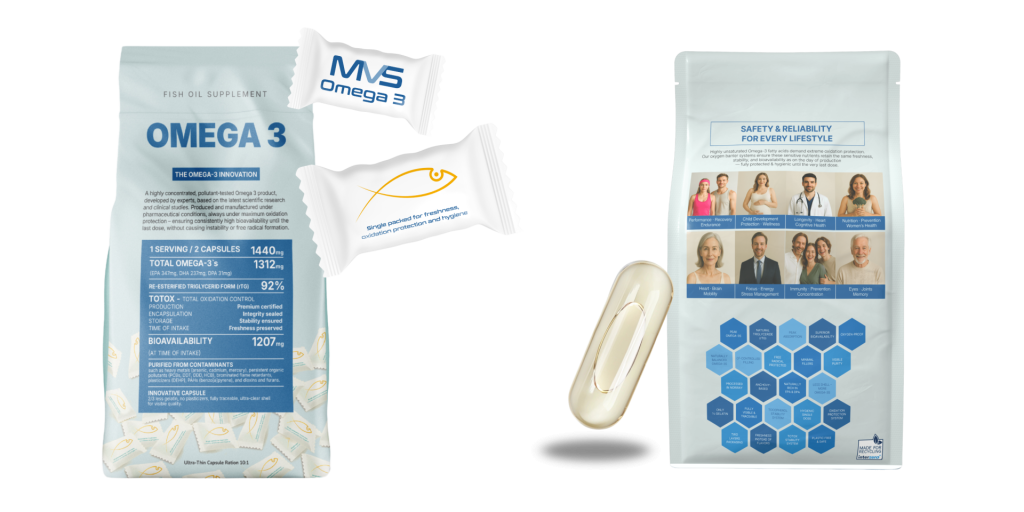Table of Contents
Omega-3 rosacea benefits overview: Rosacea is a chronic inflammatory skin condition characterized by facial redness, visible blood vessels, and sometimes, pustules or bumps. While its exact cause remains elusive, inflammation is widely recognized as a key contributor to the development and progression of this condition. In recent years, there has been growing interest in the potential therapeutic benefits of Omega-3 fatty acids in managing rosacea. This article provides an in-depth exploration of the mechanisms underlying Omega-3’s effects on rosacea and the current state of scientific understanding regarding their efficacy.
Understanding Omega-3 Fatty Acids:
Omega-3 fatty acids, including eicosapentaenoic acid (EPA) and docosahexaenoic acid (DHA), are essential polyunsaturated fats with well-established anti-inflammatory properties. These fatty acids are abundant in certain fish species (such as salmon, mackerel, and sardines), as well as in flaxseeds, chia seeds, and walnuts. Their ability to modulate inflammatory responses makes them a compelling candidate for managing conditions characterized by inflammation, including rosacea.
Potential Rosacea Benefits of Omega-3
- Anti-Inflammatory Mechanisms
In rosacea, inflammation plays a central role in the development of symptoms such as facial redness and swelling. Omega-3 fatty acids exert their anti-inflammatory effects through various mechanisms. EPA and DHA can compete with arachidonic acid, a precursor to pro-inflammatory molecules, thereby reducing the production of inflammatory mediators like prostaglandins and leukotrienes. Additionally, Omega-3s can directly influence immune cell activity, dampening excessive inflammatory responses in the skin.
- Regulation of Immune Response
Rosacea is associated with dysregulation of the immune system, leading to exaggerated inflammatory responses to triggers such as environmental factors, stress, and certain foods. Omega-3 fatty acids have been shown to modulate immune cell function, promoting a balanced immune response and mitigating the inflammatory cascade implicated in rosacea. By regulating immune cell activity, Omega-3s may help attenuate the severity and frequency of rosacea flare-ups.

- Enhanced Skin Barrier Function
Another hallmark of rosacea is impaired skin barrier function, which can exacerbate inflammation and contribute to the sensitivity and reactivity of the skin. Omega-3 fatty acids have been found to support skin barrier integrity by promoting the synthesis of ceramides, essential lipid molecules that help maintain the skin’s protective barrier. By fortifying the skin barrier, Omega-3s may help reduce sensitivity and improve resilience to external triggers in individuals with rosacea.
- Antioxidant Effects
Omega-3 fatty acids possess antioxidant properties, which can help neutralize free radicals and oxidative stress in the skin. Oxidative stress is known to exacerbate inflammation and contribute to the pathogenesis of rosacea. By scavenging free radicals, Omega-3s may help reduce oxidative damage and mitigate the severity of rosacea symptoms.
- Modulation of Lipid Mediators
In addition to their direct anti-inflammatory effects, Omega-3 fatty acids can influence the production of lipid mediators involved in inflammation resolution. For example, specialized pro-resolving mediators (SPMs) derived from Omega-3s, such as resolvins and protectins, play a crucial role in dampening inflammation and promoting tissue repair. By enhancing the resolution of inflammation, Omega-3s may contribute to the management of rosacea flare-ups and facilitate faster recovery from inflammatory episodes.
- Normalization of Sebum Production
Sebum, the skin’s natural oil, plays a role in the development of rosacea, particularly in subtypes characterized by papules and pustules. Excessive sebum production can contribute to the clogging of pores and the proliferation of bacteria implicated in rosacea pathogenesis. Omega-3 fatty acids have been shown to regulate sebum production by influencing the activity of sebaceous glands. By modulating sebum secretion, Omega-3s may help reduce the risk of pore blockage and the formation of inflammatory lesions associated with rosacea.
- Support for Microbiome Balance
Emerging research suggests that dysbiosis, or imbalance, of the skin microbiome may contribute to the development and exacerbation of rosacea. Omega-3 fatty acids possess antimicrobial properties that can help maintain a healthy balance of skin microorganisms. By promoting a diverse and resilient skin microbiome, Omega-3s may mitigate the dysbiosis observed in individuals with rosacea and contribute to the overall health of the skin barrier.
- Potential for Symptom Relief
Beyond their role in addressing the underlying inflammatory processes, Omega-3 fatty acids may offer symptomatic relief for individuals with rosacea. Some anecdotal reports and small-scale studies have suggested that Omega-3 supplementation may lead to improvements in symptoms such as skin dryness, itching, and sensitivity. While more robust clinical evidence is needed to confirm these findings, the anecdotal reports underscore the multifaceted potential of Omega-3s in managing various aspects of rosacea.
Clinical Evidence and Efficacy:
While research specifically targeting Omega-3 supplementation in rosacea is relatively limited compared to other inflammatory conditions, preliminary evidence suggests potential benefits. Several small-scale studies and anecdotal reports have indicated improvements in symptoms such as facial redness, inflammation, and overall disease severity with Omega-3 supplementation. However, larger, well-designed clinical trials are needed to conclusively establish the efficacy of Omega-3s in managing rosacea.
Dosage of Omega-3 for Rosacea
Determining the recommended daily dosage of Omega-3 fatty acids for rosacea benefits requires consideration of various factors, including the severity of symptoms, individual health status, and the specific goals of supplementation. While there is no standardized dosage established specifically for rosacea, general guidelines can offer a starting point for consideration.
For overall health maintenance and potential anti-inflammatory effects, the American Heart Association (AHA) recommends consuming at least two servings of fatty fish per week, which provides approximately 250-500 milligrams of combined EPA and DHA per day. This amount is considered beneficial for cardiovascular health and may confer some anti-inflammatory benefits relevant to rosacea.
However, for individuals seeking more pronounced therapeutic effects for inflammatory skin conditions such as rosacea, higher doses of Omega-3 supplementation may be warranted. Some dermatologists and healthcare professionals recommend doses ranging from 1,000 to 2,000 milligrams of combined EPA and DHA per day for individuals with inflammatory skin conditions. This higher dosage may help modulate the inflammatory response more effectively and potentially yield greater symptom relief.
It’s important to note that individual responses to Omega-3 supplementation can vary, and there is no one-size-fits-all approach. Factors such as body weight, overall dietary intake of Omega-3s, existing health conditions, and medication use should be taken into account when determining the appropriate dosage.
Consultation with a healthcare professional, particularly a dermatologist or nutritionist knowledgeable about rosacea management, is essential to tailor the Omega-3 supplementation regimen to individual needs. They can provide personalized recommendations based on the specific characteristics and goals of each individual, ensuring optimal safety and efficacy.
Considerations for Supplementation:
When considering Omega-3 supplementation for rosacea management, several factors should be taken into account. These include the dosage and ratio of EPA to DHA, the source of Omega-3 (fish oil, algae-based supplements, or dietary sources), and individual response variability. Consulting with a dermatologist or healthcare professional experienced in managing rosacea can help tailor an appropriate supplementation regimen based on the specific needs and characteristics of each individual.
Conclusion
In conclusion, Omega-3 fatty acids offer promising therapeutic potential in managing rosacea by virtue of their anti-inflammatory properties, regulation of immune responses, and support for skin barrier function. While further research is warranted to fully elucidate their efficacy and optimal use in rosacea management, existing evidence suggests that Omega-3 supplementation may hold promise as a complementary approach to conventional therapies.
As our understanding of the complex pathophysiology of rosacea continues to evolve, Omega-3s represent a compelling avenue for exploration in the quest for effective management strategies for this challenging dermatological condition.
MVS Omega-3 — Setting a New Standard in Purity, Stability, and Bioavailability
Developed by MVS Pharma’s medical and pharmaceutical experts, MVS Omega-3 represents a new generation of scientifically designed Omega-3 supplements. With a 92% natural rTG structure, verified bioavailability of 1207 mg, and our proprietary T-TOX™ oxidation control system, it ensures exceptional purity, stability, and absorption. Each batch meets European Pharmacopeia standards and is tested for over 20 potential contaminants — setting a benchmark for transparency and trust in modern nutritional science.

Not all Omega-3 supplements are created equal. The more unsaturated and effective Omega-3 molecules become, the more sensitive they are to air exposure — making oxidation protection the single most critical factor for preserving both safety and bioavailability. Once oxidation begins, oil turns rancid, loses efficacy, and may even generate free radicals.
At MVS Pharma, this challenge defined our mission. We engineered MVS Omega-3 as a next-generation formulation designed for uncompromised purity, verified stability, and maximum biological usability.
Key Facts:
- 90% Purified Omega-3 Concentration — delivering 1440 mg total oil with 1312 mg active Omega-3s (EPA 784 mg, DHA 518 mg) per serving.
- 92% Re-esterified Triglyceride (rTG) Form — structurally identical to natural fish oil for superior absorption (1207 mg bioavailable) and full physiological compatibility.
- T-TOX™ Total Oxidation Control System — exclusive German oxidation-management technology ensuring freshness and molecular integrity from production to the last capsule.
- Dual-Layer Packaging Protection — prevents oxidation, preserves hygiene, and guarantees stability throughout the product’s entire lifecycle.
- Ultra Thin Capsule Release 3.0™ — 2/3 less gelatin, no plasticizers, and >91% active ingredient load for transparency, purity, and optimized payload.
- Natural Tocopherol Matrix (α, β, γ, δ) — balanced antioxidant system calibrated to protect high-purity oil without destabilization.
- Pharma-Standard Purification & Testing — each batch is verified to meet European Pharmacopeia standards and is screened for over 20 contaminants, including heavy metals, PCBs, dioxins, PAHs, and plasticizers.
The result is an ultra-pure, oxidation-protected Omega-3 supplement that maintains its natural structure, freshness, and full efficacy until the final dose — ensuring consistent support for cardiovascular, cognitive, visual, and immune health.
Disclaimer: As a service to our readers, MVS Pharma GmbH publishing provides access to our library of archived content in our blog. Please note the date of the last review or update on all articles. No content on this site should ever be used as a substitute for direct medical advice from your doctor or other qualified clinician.
Sources:
- Science direct: “Dietary supplementation of n-3 PUFAs ameliorates LL37-induced rosacea-like skin inflammation via inhibition of TLR2/MyD88/NF-κB pathway”
- Learn skin article: “OMEGA-3 SUPPLEMENTATION FOR DRY EYES AND OCULAR ROSACEA”
- National Library of Medicine: “Dietary supplementation of n-3 PUFAs ameliorates LL37-induced rosacea-like skin inflammation via inhibition of TLR2/MyD88/NF-κB pathway”
- National Library of Medicine: “A Randomized Controlled Trial of Omega 3 Fatty Acids in Rosacea Patients with Dry Eye Symptoms”


